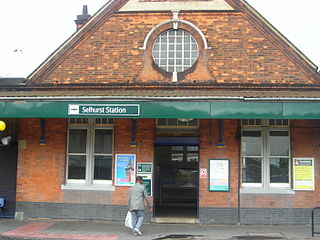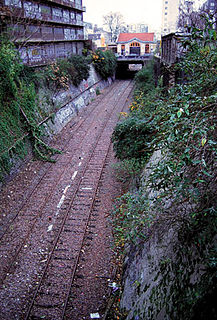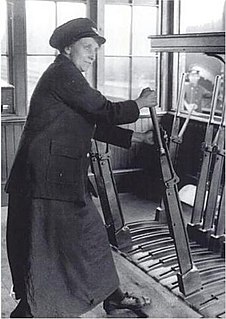
The Société nationale des chemins de fer français is France's national state-owned railway company. Founded in 1938, it operates the country's national rail traffic along with Monaco, including the TGV, on France's high-speed rail network. Its functions include operation of railway services for passengers and freight, as well as maintenance and signalling of rail infrastructure. The railway network consists of about 35,000 km (22,000 mi) of route, of which 2,600 km (1,600 mi) are high-speed lines and 14,500 km (9,000 mi) electrified. About 14,000 trains are operated daily.

The Northern City Line is a commuter railway line in England, which runs from Moorgate station to Finsbury Park in London with services running beyond. It is part of the Great Northern Route services, and operates as the south-eastern branch of the East Coast Main Line (ECML). It is underground from Moorgate to Drayton Park in Highbury, from which point it runs in a cutting until joining the ECML south of Finsbury Park. Its stations span northern inner districts of Greater London southwards to the City of London, the UK's main financial centre. Since December 2015, its service timetable has been extended to run into the late evenings and at weekends, meeting a new franchise commitment for a minimum of six trains per hour until 23:59 on weekdays and four trains per hour at weekends.

Moorgate is a central London railway terminus and connected London Underground station on Moorgate in the City of London. Main line railway services for Hertford, Welwyn Garden City, Stevenage and Letchworth are operated by Great Northern, while the Underground station is served by the Circle, Hammersmith & City, Metropolitan and Northern lines.

The Chiltern Main Line is a railway line which links London (Marylebone) and Birmingham, the United Kingdom's two largest cities, by a 112-mile (180 km) route via High Wycombe, Bicester, Banbury, Leamington Spa and Solihull.

The Maritime Line is a railway line that runs in the valley of the River Fal from Truro, the county town, to Falmouth on the south coast of Cornwall, England.

The Looe Valley Line is an 8+3⁄4 miles (14 km) community railway from Liskeard to Looe in Cornwall, United Kingdom, that follows the valley of the East Looe River for much of its course. It is operated by Great Western Railway.

The St Ives Bay Line is a 4.25 miles (6.84 km) railway line from St Erth to St Ives in Cornwall, England, United Kingdom. It was opened in 1877, the last new 7 ft broad gauge passenger railway to be constructed in the country. Converted to standard gauge in 1892, it continues to operate as a community railway, carrying tourists as well as local passengers. It has five stations including the junction with the Cornish Main Line at St Erth.

Selhurst railway station is in the London Borough of Croydon in south London, 9 miles 31 chains (15.1 km) along the line from London Victoria. It is operated by Southern, which also provides all the train services. The station is in Travelcard Zone 4.

Aston railway station serves the districts of Aston and Nechells in Birmingham, England. The passenger entrance is on Lichfield Road. The station is on the Cross-City Line and the Chase Line. It is one of two local stations for Aston Villa Football Club and near to the Aston Expressway and to Gravelly Hill Interchange.

Plymouth railway station serves the city of Plymouth, Devon, England. It is on the northern edge of the city centre, close to the North Cross roundabout. It Is the second busiest station in the county of Devon, and is the largest of the six surviving stations in Plymouth.

Shrewsbury railway station is in Shrewsbury, Shropshire, England. Built in 1848, it was designated a grade II listed building in 1969.

The South Wales Main Line, originally known as the London, Bristol and South Wales Direct Railway or simply as the Bristol and South Wales Direct Railway, is a branch of the Great Western Main Line in Great Britain. It diverges from the core London-Bristol line at Royal Wootton Bassett beyond Swindon, first calling at Bristol Parkway, after which the line continues through the Severn Tunnel into South Wales.

Paris' former Chemin de fer de Petite Ceinture, also colloquially known as La Petite Ceinture, was a circular railway built as a means to supply the city's fortification walls, and as a means of transporting merchandise and passengers between Paris' major rail-company stations. Beginning as two distinct 'Ceinture Syndicate' freight and 'Paris-Auteuil' passenger lines from 1851, these lines formed an arc that surrounded the northern two thirds of Paris, an arc that would become a full circle of rail around the capital when its third Ceinture Rive Gauche section was built in 1867.

SimSig is a mixed donationware and commercial Windows-based train simulator of modern railway signalling systems in Great Britain, from the point of view of a railway signaller. Users have also had success running SimSig on Linux using Wine.

The London–Aylesbury line is a railway line between London Marylebone and Aylesbury, going via the Chiltern Hills; passenger trains are operated by Chiltern Railways. Nearly half of the line is owned by London Underground, approximately 16 miles (26 km) – the total length of the passenger line is about 39 miles (63 km) with a freight continuation.
The Ormskirk branch line is a railway line in Lancashire, England, running between Preston and Ormskirk. The train service is operated by Northern Trains, who usually operate class 150, 156, and 158 units. The line is the northern section of the former Liverpool, Ormskirk and Preston Railway; the line from Ormskirk to Liverpool is now part of Merseyrail's Northern Line. Prior to the introduction of the 1970–71 London Midland Region timetable, it was a secondary main line from Liverpool to Scotland, Blackpool, and Yorkshire. From 4 May 1970, however, the line was severed at Ormskirk. With express trains eliminated, stopping services at the village stations en route were improved, and have retained a similar frequency to this day.

The railway network of Great Britain is operated with the aid of a number of documents, which have been sometimes termed "technical manuals", because they are more detailed than the pocket-timetables which the public encounters every day. Historically, they were classified PRIVATE and not for publication, however since rail privatisation they are now more widely available, mostly in digital form, because they are produced centrally and not by the regional rail operators.

A signalman or signaller is an employee of a railway transport network who operates the points and signals from a signal box in order to control the movement of trains.

The Grande Ceinture line is a railway line round Paris 15 km from the Boulevard Périphérique. The decision to build it was taken at the end of the 19th century, to connect the radial lines linking the capital to the provinces and to relieve the existing Ligne de Petite Ceinture.
In Great Britain, the Sectional Appendix is a railway document compiled by Network Rail and is the official definition of railway infrastructure, giving a detailed description of all railway lines owned by Network Rail. It has traditionally been published in printed format, originally as a bound book and subsequently in loose-leaf format, for ease of updating.